
 |
IOW · NewsletterDecember 2024 |
|---|
| Newsletter online: en | de | ||
Topics |
||
|
News » 10. Baltic Earth Summer School » Northern German Science Award » UNESCO's appreciation of the long-term monitoring programme » Biennial report 2022 / 2023 » Heads » New Scientific Council at the IOW » New spokespersons for the research areas » New Projects » Second funding phase Ocean Technology Campus » TRR 181 has been extended » SeaStore 2 started » Peatland climate protection at the Baltic Sea coast » Project STATUS has begun » Transfer » Facts on climate changein the Baltic Sea Region » Events » Long Night of the Science » Baltic Sea-Day in Stralsund » Public Relations » IOW on the unification ceremony » Warnemünder evenings » Publications » Marine heatwaves in the Baltic Sea » A look back at 50,000 years of South Pacific hydroclimate » Marine Science Reports No 128 » Jobs » Co-Head of the International Baltic Earth Secretariat |
||
Retrospectives are insights. |
||
|
This newsletter invites you, dear readers, to look back with us on the past months and years at the IOW. In addition to a two-year review of 2022 and 2023 in a new design, you will find exciting reports on successes, events and developments that have recently shaped our institute. We hope you enjoy reading! 
Oliver Zielinski | Director |
||
 |
||
News |
||
Baltic Earth network provides basic knowledge about the Baltic Sea |
||
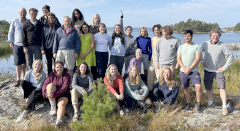 |
From 26th of August to 2nd of September 2024, the Baltic Earth Research Network Summer School took place for the tenth time. This time, 18 students from all over the Baltic Sea region came to the field station of the Stockholm University Baltic Sea Centre on the Swedish island of Askö. In addition to general basic knowledge of the Baltic Sea, the programme focused on climate change in the region and its consequences. The summer school programme was supported by researchers from the IOW, the Helmholtz Centre Hereon and the Swedish Södertörn University. |
|
Northern German Science Award for the discovery and research
|
||
 |
In 2021, geologists discovered an unusual row of stones almost a kilometre long at the bottom of Mecklenburg Bay. The site is located around 10 kilometres off the coast of Rerik in 21 water depth. The approximately 1,500 stones are piled up so regularly that a natural formation seems unlikely. A team of researchers from various disciplines has now come to the conclusion that Ice Age hunters built this structure around 11,000 years ago to hunt reindeer. This is the first time that such a hunting structure has been discovered in the Baltic Sea region. Coordinated by Jacob Geersen from the IOW, the University of Rostock, the Christian-Albrechts-Universität zu Kiel and the Leibniz Centre for Archaeology (LEIZA) are involved in SEASCAPES as project partners. The team is also working closely with the Mecklenburg-Western Pomerania State Office for Culture and Monument Preservation and the Schleswig-Holstein State Archaeological Office. The University of Rostock submitted the project (SEASCAPES) for the North German Science Prize. |
|
UNESCO recognises the IOW's long-term observation programme |
||
 |
Under the title BALTICOBS, the IOW's Baltic Sea long-term observation programme has been one of the ‘Actions of the Decade’ of the UN Ocean Decade since June 2024. The United Nations appreciates the data series, which goes back more than 50 years and allows an assessment of the physical, chemical and biological state of the Baltic Sea ecosystem. As a global initiative, the Ocean Decade is the first to focus on the global ocean and aims to promote worldwide networking between science and the ‘stake holders’ in order to keep the ocean clean, healthy and productive in the future. |
|
The new biennial report 2022/2023 has been published! |
||
 |
The years 2022 and 2023 were eventful at the IOW: a new director, the coronavirus pandemic, water damage in the building, a new specific extraordinary item of expenditure (so-called "Sondertatbestand") and above all: great research results, new projects, prizes, awards and successes in knowledge exchange. (The full biennial report is currently only available in German.) |
|
Heads |
||
Newly elected Scientific Council for the IOW |
||
|
On 17th of October 2024, the colleagues from the sections were elected to the scientific council:
|
||
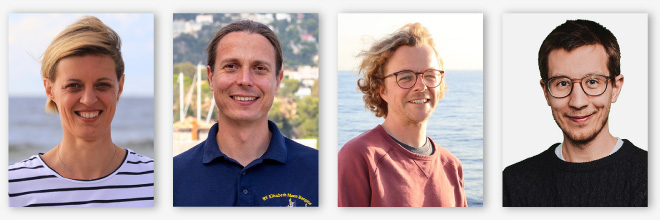 |
||
|
From left to right: Isabell Klawonn, Henry Bittig, Jacob Geersen, Florian Börgel |
||
New spokespersons for the research areas |
||
|
New spokespersons have been elected for the three IOW's research areas:
|
||
| RA 1 - Key Processes across Scales: | ||
 |
||
| RA 2 - Coastal Seas in Transition: | ||
 |
||
| RA 3 - Emerging Technologie: | ||
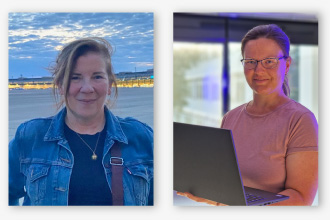 |
||
New Projects |
||
Starting signal for the second funding phase - The OTC success story continues |
||
 |
With a focus on sustainable use of the sea, the ‘Ocean Technology Campus Rostock’ has been developing as a centre for marine technology innovation since 2021 and also promotes research and training in this field. Having emerged from the ‘Clusters4Future’ competition organised by the Federal Ministry of Education and Research (BMBF), the future cluster based in Rostock is now entering the next round with a renewed BMBF funding commitment of 15 million euros for a further three years. On 9 and 10 October 2024, a good 100 representatives of the participating cluster partners met for a kick-off event for the second funding phase. Duration: 01.11.2024 - 31.10.2027 · Coordinator of the innovation cluster “Ocean Open Innovation”: Dr. Regine Labrenz · Funding: BMBF - Bundesministerium für Bildung und Forschung |
|
Third funding phase of the DFG Collaborative Research Centre TRR 181 has begun |
||
 |
||
|
Duration: 01.07.2016 - 30.06.2028 · Coordination: University of Hamburg, Institute of Oceanography · Project manager (IOW): Prof. Dr. Hans Burchard · Funding: DFG - Deutsche Forschungsgemeinschaft |
||
Integrative consideration of the greenhouse gas balance in the reintroduction
|
||

|
Seagrass meadows promote biodiversity and provide important ecosystem services such as carbon sequestration and sediment stabilisation, which are of great importance for coastal protection. For this reason, there is great interest in the reintroduction of lost seagrass stocks in the German Baltic Sea. SeaStore 2 provides the scientific basis for this. A particular focus is on the greenhouse gas balance of seagrass meadows, the resulting CO2 storage and thus the contribution to natural climate protection. The work of the IOW is focused on this area. In close co-operation between the IOW and the University of Greifswald (UG), the trace gas distributions in the water column (IOW) and the greenhouse gas fluxes (UG) are determined seasonally at two selected sites in Schleswig-Holstein and Mecklenburg-Western Pomerania. Duration: 01.08.2024 - 31.07.2027 · Coordination: Ludwig-Franzius-Institute for Hydraulic, Estuarine and Coastal Engineering, Leibniz Universität Hannover · Project manager: Prof. Dr. Gregor Rehder · Funding: BMBF - Bundesministerium für Bildung und Forschung |
|
28 million euros for peatland climate protection on the Baltic Sea Coast |
||
 |
The joint project ‘Peatland Climate Protection at the Baltic Sea Coast’ was launched in Bresewitz on 4 October. Federal Environment Minister Steffi Lemke visited the restored polder area in the municipality of Pruchten together with Climate Protection and Environment Minister Dr Till Backhaus. In their luggage they had a funding decision for 28 million euros. The project is being implemented as part of the Natural Climate Protection Action Programme (ANK) and coordinated by Georg Nikelski from the OSTSEESTIFTUNG. The project ‘Mire Climate Protection: Model Project Mire Climate Protection on the Baltic Sea Coast’ has already started at the IOW with sub-project 1: ‘Reduction of Nitrogen Emissions from Coastal Mires’. Colleagues from Maren Voß's working group are investigating the material and gas flows within rewetted moors in order to derive recommendations for the restration process. The colleagues are already contributing data and findings from studies in Drammendorf as part of the BALTIC TRANSCOAST project. According to Maren Voß, it has been shown there that the amount of nitrogen released into the Baltic Sea during rewetting can be enormous. According to Maren Voß, simply removing dams or dykes and allowing the Baltic Sea water to flow into the area has proven to be a less sensible method. Funding of € 800,000 has been secured for a post-doctoral position at the IOW for 8 1/2 years. Duration: 15.03.2024 - 14.03.2034 · Coordination: Ostseestiftung · Project manager (IOW): Prof. Dr. Maren Voß · Funding: BfN - Federal Agency for Nature Conservation |
|
STATUS of biogenic reefs in the Baltic Sea |
||

|
The BfN-funded STATUS project - STATUS of biogenic reefs in the Baltic Sea with a focus on carbon sequestration - will investigate three aspects of mussel beds in the Baltic Sea from 1 October 2024 to 30 September 2027: their distribution, biomass and their potential to absorb or release carbon dioxide. The aim is to develop a model that can predict their carbon footprint under certain environmental conditions. Jahangir Vajedsamiei (postdoc) and Annabell Apitz (technician) have joined Michael Zettler's working group to realise the project. The first step is to identify and analyse existing data sets - ‘there is already an impressive amount of knowledge about this at the IOW,’ says Jahangir. This extensive data will be supplemented by experiments in mesocosms, research expeditions and dives. The IOW is working closely with GEOMAR Helmholtz Centre for Ocean Research Kiel, Alfred Wegener Institute Helmholtz Centre for Polar and Marine Research (AWI) and the Federal Agency for Nature Conservation (BfN) on this project. Duration: 01.10.2024 - 30.09.2027· Project manager: Dr. Michael L. Zettler · Funding: BfN - Federal Agency for Nature Conservation |
|
Transfer |
||
Updated fact sheet on climate change in the Baltic Sea region published |
||
 |
How is climate change affecting the Baltic Sea and what are the likely impacts on the marine environment? The international research network Baltic Earth and the Helsinki Commission for the Protection of the Baltic Sea HELCOM have now published an updated version of the factual overview first published in 2021 and prepared for the general public. It incorporates the latest scientific findings from around 90 researchers from the entire Baltic Sea region, including experts from the IOW. Markus Meier is co-editor of the factsheet. |
|
Events |
||
| 📅 15.05.2025 | 16:00 to 22:00 | ||
22. Long Night of the Science |
||
|
The IOW is taking part in the 22nd ‘Long Night of the Science’. This year's motto is: Curiosity never sleeps. The IOW will be presenting its research together with other scientific institutions and the University of Rostock on the Südstadt-Campus. |
||
| 📅 05.06.2025 | ||
Baltic Sea-Day “Healthy Baltic Sea – Healthy people“
|
||
|
The IOW is one of the organisers of the 5th Baltic Sea Day. It will take place for the first time in 2025 in Stralsund in front of the Ozeaneum. The title this year is: ‘Healthy Baltic Sea - Healthy People’. An ‘open ship’ is planned on three research vessels that regularly sail the Baltic Sea. And a deep insight into the research of the institutions dedicated to the Baltic Sea Research: Federal Maritime and Hydrographic Agency (BSH), German Maritime Museum Stralsund (DMM), Leibniz Institute for Baltic Sea Research Warnemünde (IOW), Thünen Institute for Baltic Sea Research (TI-OF). |
||
Public relations |
||
| 03.10.2024 - 06.10.2024 | ||
Baltic Sea research for guests from all over Germany |
||
 |
On October 3rd 2024, at the nationwide unification celebrations in Schwerin, the IOW also presented itself on the MV-Mile - at a joint stand with the Leibniz-Institutes from all over Mecklenburg-Vorpommern. There were three days of celebrations in Schwerin - and colleagues from the IOW were also there for three days. |
|
| 04.07.2024 - 12.09.2024 | ||
The Warnemünde evenings - successfully relaunched |
||
 |
This year, the IOW once again invited Warnemünde residents and guests to the IOW - and they were happy to come in large numbers. The „Warnemünder Evenings“ had been eagerly awaited by many after a five-year-break. 500 guests attended one of the nine evenings - some came several times. Wolfgang Matthäus, Oliver Zielinski, Gregor Rehder, Matthias Labrenz, Leonie Barghorn, Ulf Gräwe, Joanna Waniek, Christiane Hassenrück together with Franziska Tanneberger from the University of Greifswald and Helge Arz each gave an insight into their research. The topics ranged from the history of marine research at Warnemünde to the darkening of the oceans and research into climate change, microplastics, world war munitions and vibrions in the oceans to deep drilling in the South Pacific, which provides a glimpse into eight million years of climate history. A big thank you to everyone who made the Warnemünder Evenings possible! |
|
Publications |
||
Marine heatwaves in the Baltic Sea -
|
||
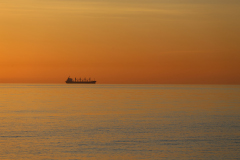
|
Marine heatwaves - periods in which the upper layers of water in the sea temporarily heat up to an unusually high temperature - are occurring with increasing frequency worldwide. Recent studies by the IOW have now confirmed this trend for the Baltic Sea. IOW researchers analysed very large meteorological and hydrographic data sets and identified the specific wind and weather conditions that cause Baltic Sea heatwaves. They also analysed the propagation of heat waves to the bottom of the Baltic Sea for the first time and proved that they can lead to a drastic lack of oxygen even in otherwise well-aerated coastal waters. References:
Gröger, M., Dutheil, C., Börgel, F., Meier, HEM (2024): Drivers of marine heatwaves in a stratified marginal sea. Climate Dynamics 7062
https://doi.org/10.1007/s00382-023-07062-5 Safonova, K., Meier, H.E.M. & Gröger, M. (2024): Summer heatwaves on the Baltic Sea seabed contribute to oxygen deficiency in shallow areas. Commun Earth Environ 5, 106.
https://doi.org/10.1038/s43247-024-01268-z Scientific contact:
Prof. Dr. Markus Meier | Head of the Department of Physical Oceanography |
|
A look back at 50,000 years of South Pacific hydroclimate shows: The ‘earth's slate’ also influences how wet it gets |
||
 |
Understanding the causes of changing precipitation and moisture levels in the Earth's past is an important prerequisite for being able to better estimate future changes in the Earth's hydroclimate and take them into account in climate modelling. A research team led by the IOW has now succeeded for the first time in analysing around 50,000 years of hydroclimate in the mid-latitudes of the south-east Pacific using special indicators in marine sediment cores. The most important result: natural fluctuations in the Earth's orbital parameters exert a decisive influence. The study was recently published in the scientific journal Nature Communications. Reference:
J. Kaiser, E. Schefuß, J. Collins, R. Garreaud, J.-B. W. Stuut, N. Ruggieri, R. De Pol-Holz & F. Lamy (2024): „Orbital modulation of subtropical versus subantarctic moisture sources in the southeast Pacific mid-latitudes” Nat. Commun. 15, Article Number: 7512
https://doi.org/10.1038/s41467-024-51985-4 |
|
Hydrographic-hydrochemical assessment of the Baltic Sea 2023 |
||
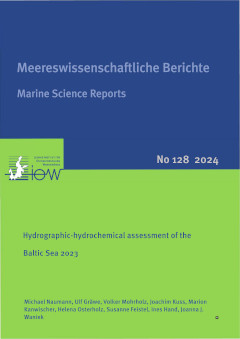 |
The report describes the hydrographic-hydrochemical conditions in the western and central Baltic Sea in 2023. Based on the meteorological conditions, the horizontal and vertical distribution patterns of temperature, salinity horizontal and vertical distribution patterns of temperature, salinity, oxygen, hydrogen sulphide and nutrients with seasonal resolution. Reference:
Michael Naumann, Ulf Gräwe, Volker Mohrholz, Joachim Kuss, Marion Kanwischer, Helena Osterholz, Susanne Feistel, Ines Hand, Joanna J. Waniek,: Hydrographic-hydrochemical assessment of the Baltic Sea 2023. Meereswiss. Ber., Warnemünde, 128 (2024)
https://doi.io-warnemuende.de/10.12754/msr-2015-0097 |
|
Jobs |
||
|
Further job offers at the IOW can be found here. |
||
| Jobs | Data Protection | Legal Notice | Contact | ||
|
If you would like to receive our newsletter regularly from now on you can register here. If you no longer wish to receive our newsletter you can unsubscribe here. |
||